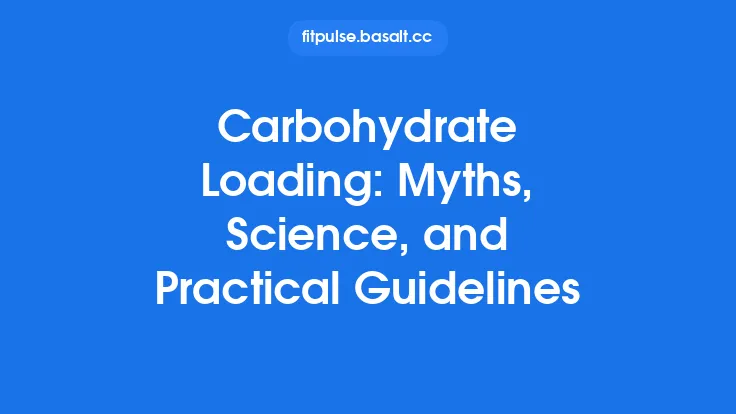During physical activity the body must continuously supply adenosine‑triphosphate (ATP) to contracting muscle fibers. This ATP is generated by breaking down three primary macronutrient stores—carbohydrate, fat, and protein—each of which follows distinct biochemical pathways, contributes different amounts of energy, and is recruited to varying degrees depending on the characteristics of the exercise bout. Understanding how these fuels are mobilized, transported, and oxidized provides a solid foundation for designing training programs, nutritional plans, and recovery protocols that align with an athlete’s performance goals.
Carbohydrate Metabolism During Exercise
1. Primary storage forms
- Muscle glycogen: Stored as a highly branched polymer of glucose within the cytosol of skeletal muscle fibers. It is directly accessible to the muscle’s glycolytic enzymes and does not require transport across the sarcolemma.
- Liver glycogen: Serves as a systemic glucose reservoir, maintaining blood glucose concentrations through hepatic glycogenolysis.
2. Pathways of utilization
- Glycolysis: The ten‑step enzymatic cascade that converts glucose‑6‑phosphate to pyruvate, yielding a net 2 ATP per glucose molecule and producing NADH for subsequent oxidative phosphorylation.
- Oxidative phosphorylation of pyruvate: In the presence of sufficient oxygen, pyruvate enters the mitochondria, is converted to acetyl‑CoA by pyruvate dehydrogenase (PDH), and feeds the tricarboxylic acid (TCA) cycle. This route yields ~30–32 ATP per glucose molecule.
3. Rate of carbohydrate oxidation
- At low to moderate intensities (≈30–60 % VO₂max), carbohydrate oxidation typically ranges from 0.5 to 1.0 g · min⁻¹.
- As intensity rises above the “crossover point” (≈65–70 % VO₂max for most individuals), the reliance on carbohydrate can increase to 2–3 g · min⁻¹, reflecting the faster ATP yield per unit of substrate.
4. Regulation
- Hormonal control: Epinephrine stimulates glycogen phosphorylase, accelerating glycogen breakdown. Insulin suppression during exercise reduces glucose uptake by non‑active tissues, preserving circulating glucose for active muscle.
- Allosteric effectors: AMP, ADP, and inorganic phosphate (Pi) activate glycogen phosphorylase, while high concentrations of ATP inhibit it.
- Enzyme activation: Calcium released during muscle contraction activates phosphorylase kinase, which in turn phosphorylates glycogen phosphorylase, enhancing glycogenolysis.
5. Practical implications
- Pre‑exercise carbohydrate loading (e.g., 8–10 g · kg⁻¹ body mass 24 h before a prolonged event) maximizes muscle glycogen stores, delaying the onset of carbohydrate depletion.
- During‑exercise carbohydrate ingestion (30–60 g · h⁻¹ of a glucose‑fructose blend) sustains blood glucose, attenuates the decline in muscle glycogen, and supports higher intensities for longer durations.
Fat Metabolism During Exercise
1. Primary storage forms
- Intramuscular triglycerides (IMTG): Small lipid droplets located within the cytosol of muscle fibers, especially abundant in type I (oxidative) fibers.
- Adipose tissue triglycerides: The largest systemic lipid reservoir, mobilized as free fatty acids (FFAs) bound to albumin in the plasma.
2. Pathways of utilization
- Lipolysis: Hormone‑sensitive lipase (HSL) and adipose triglyceride lipase (ATGL) hydrolyze triglycerides into glycerol and FFAs.
- Transport: FFAs are shuttled across the capillary endothelium via fatty acid transport proteins (FATPs) and CD36, then bound to intracellular fatty acid‑binding proteins (FABPs).
- β‑Oxidation: Within mitochondria, FFAs undergo a series of dehydrogenation, hydration, and thiolysis steps, producing acetyl‑CoA, NADH, and FADH₂. Each acetyl‑CoA enters the TCA cycle, generating ~106 ATP per palmitate molecule (C16:0).
3. Rate of fat oxidation
- At low intensities (≈30 % VO₂max), fat oxidation can reach 0.5–0.7 g · min⁻¹.
- The maximal fat oxidation rate (MFO) typically occurs at 50–65 % VO₂max, ranging from 0.8 to 1.2 g · min⁻¹ in trained individuals.
- Above this intensity, the absolute contribution of fat declines sharply due to limited oxygen availability for β‑oxidation and the inhibitory effect of high carbohydrate flux on lipolysis (the “Randle cycle”).
4. Regulation
- Catecholamines (epinephrine, norepinephrine) stimulate HSL in adipose tissue, increasing plasma FFA concentrations.
- Insulin exerts a potent anti‑lipolytic effect; its decline during exercise removes this brake, facilitating FFA release.
- AMP‑activated protein kinase (AMPK) activation during prolonged low‑intensity work up‑regulates fatty acid transporters and mitochondrial biogenesis, enhancing oxidative capacity.
5. Practical implications
- Endurance training (≥60 % VO₂max, >60 min sessions, 3–5 times week) expands mitochondrial density and capillary networks, raising MFO and sparing glycogen.
- Nutritional periodization: Training in a fasted state or with low carbohydrate availability can augment the muscle’s ability to oxidize fat, though this must be balanced against potential performance decrements in high‑intensity work.
Protein Utilization and Its Role in Exercise Metabolism
1. Sources of amino acids
- Plasma amino acids: Derived from dietary protein digestion and hepatic deamination.
- Intramuscular protein pools: Myofibrillar proteins (actin, myosin) and sarcoplasmic proteins (enzymes, structural proteins).
2. Oxidative contribution
- At rest and during low‑intensity exercise, protein oxidation accounts for ~5–7 % of total energy expenditure.
- During prolonged endurance activity (>2 h), especially when carbohydrate stores are depleted, protein oxidation can rise to 10–12 % of total energy, providing ~0.1–0.2 g · min⁻¹ of amino acids for ATP production.
3. Pathways
- Transamination: Amino groups are transferred to α‑ketoglutarate, forming glutamate and corresponding α‑keto acids.
- Deamination: Glutamate undergoes oxidative deamination via glutamate dehydrogenase, releasing ammonia (NH₃) and producing α‑ketoglutarate, which enters the TCA cycle.
- Urea cycle: Ammonia is detoxified in the liver, forming urea for excretion.
4. Functional significance
- Gluconeogenesis: Certain amino acids (e.g., alanine, lactate, glutamine) serve as substrates for hepatic glucose production, helping maintain blood glucose during extended bouts.
- Repair and remodeling: Exercise‑induced muscle protein turnover is essential for adaptation; the net balance (synthesis vs. breakdown) determines hypertrophy or atrophy.
5. Practical implications
- Pre‑ and post‑exercise protein intake (≈0.3 g · kg⁻¹ body mass) ensures an adequate amino acid pool for both immediate oxidation and subsequent muscle protein synthesis.
- Leucine‑rich sources (whey, soy, dairy) stimulate the mTOR pathway, promoting anabolic signaling after resistance or high‑intensity interval sessions.
Interplay Between Carbohydrate, Fat, and Protein
- Substrate competition (Randle effect) – Elevated carbohydrate oxidation raises cytosolic citrate and acetyl‑CoA, inhibiting phosphofructokinase‑1 (PFK‑1) and HSL, thereby suppressing fat oxidation. Conversely, high FFA availability can inhibit PDH, reducing carbohydrate oxidation.
- Glycogen sparing – Enhanced fat oxidation, achieved through endurance training or strategic low‑carbohydrate sessions, conserves muscle glycogen, extending the time to fatigue during prolonged efforts.
- Protein as a “backup” – When both glycogen and plasma glucose are low, amino acids become a more prominent gluconeogenic substrate, supporting blood glucose and providing a modest ATP contribution.
- Recovery synergy – Post‑exercise carbohydrate replenishment restores glycogen, while protein provides essential amino acids for repair. The combined intake (≈1.0–1.2 g · kg⁻¹ body mass of carbohydrate plus 0.2–0.3 g · kg⁻¹ of protein within 30 min) maximizes glycogen resynthesis rates and stimulates muscle protein synthesis.
Factors Influencing Substrate Preference
| Factor | Effect on Carbohydrate Utilization | Effect on Fat Utilization | Effect on Protein Utilization |
|---|---|---|---|
| Exercise intensity | ↑ intensity → ↑ glycolytic flux, ↑ PDH activity | ↑ intensity → ↓ β‑oxidation (oxygen limitation) | Minimal change, but prolonged high intensity can ↑ proteolysis |
| Exercise duration | Early phases rely on glycogen; later phases depend on plasma glucose | Prolonged low‑intensity work ↑ lipolysis & IMTG oxidation | >2 h → ↑ gluconeogenic amino acid oxidation |
| Training status (endurance) | Trained athletes have higher glycogen stores, slower depletion | ↑ mitochondrial density → ↑ MFO, improved glycogen sparing | Enhanced protein turnover efficiency |
| Nutritional state (fed vs. fasted) | Fed → ↑ insulin, ↑ glucose uptake, ↓ fat oxidation | Fasted → ↓ insulin, ↑ HSL activity, ↑ plasma FFA | Fasted → ↑ proteolysis for gluconeogenesis |
| Sex hormones (estrogen, testosterone) | Estrogen can modestly ↑ lipid oxidation, sparing carbs | Testosterone promotes muscle protein synthesis, may modestly ↑ glycogen storage | Both hormones influence protein turnover rates |
| Environmental temperature | Heat → ↑ carbohydrate oxidation to meet rapid ATP demand | Cold exposure can ↑ fat oxidation for thermogenesis | Minimal direct effect, but stress hormones may increase proteolysis |
Nutritional Strategies to Optimize Fuel Utilization
- Periodized carbohydrate intake
- High‑carb days: Align with key training sessions or competitions to maximize glycogen availability.
- Low‑carb days: Pair with easy‑recovery workouts to stimulate fat oxidation adaptations.
- Intra‑exercise fueling
- Carbohydrate‑only solutions (6 % glucose) are sufficient for efforts <60 min.
- Carbohydrate‑fructose blends (2:1 ratio) improve absorption rates, supporting >90 min efforts.
- Protein timing
- Pre‑exercise: 15–30 g of high‑quality protein 1–2 h before training can raise plasma amino acid levels, reducing muscle protein breakdown.
- Post‑exercise: 20–40 g within the anabolic window (0–2 h) maximizes muscle protein synthesis.
- Fat‑focused meals
- Incorporate omega‑3 rich sources (e.g., fatty fish, flaxseed) to modulate inflammation and potentially enhance mitochondrial function.
- Avoid excessive saturated fat immediately before high‑intensity work, as it may delay gastric emptying.
- Hydration and electrolyte balance
- Adequate fluid status supports substrate transport (e.g., FFA delivery) and maintains plasma volume, influencing substrate delivery to working muscles.
Practical Applications for Different Exercise Modalities
| Modality | Dominant Fuel(s) | Recommended Nutritional Approach |
|---|---|---|
| Steady‑state endurance (≥60 min, 50–65 % VO₂max) | Primarily fat, with significant carbohydrate contribution as duration extends | Emphasize carbohydrate loading 24 h prior; consider 30–60 g · h⁻¹ carbohydrate during the event; ensure adequate protein intake for recovery |
| Tempo or threshold training (≈75–85 % VO₂max, 20–40 min) | Predominantly carbohydrate, with limited fat oxidation | Pre‑exercise carbohydrate (1–2 g · kg⁻¹ 2–3 h before); optional intra‑session carbohydrate if >30 min; post‑session protein‑carb blend |
| High‑intensity interval training (HIIT, ≤2 min bouts, >90 % VO₂max) | Rapid carbohydrate utilization; minimal fat contribution | Fast‑acting carbohydrate (e.g., glucose solution) 30 min before; post‑session protein (0.3 g · kg⁻¹) to aid repair |
| Resistance training (≤2 h, moderate intensity) | Mixed carbohydrate and protein; fat contribution modest | Protein‑rich meal 1–2 h pre‑workout; intra‑session carbohydrate optional for long sessions; post‑workout protein‑carb (0.4 g · kg⁻¹ carbohydrate) for glycogen replenishment and MPS |
| Ultra‑endurance events (>4 h) | Progressive shift from carbohydrate to fat, with increasing reliance on protein for gluconeogenesis | Aggressive carbohydrate loading; staged carbohydrate intake during the event (60–90 g · h⁻¹); periodic protein (≈15–20 g) to limit muscle catabolism; electrolyte management |
Monitoring and Adjusting Fuel Use
- Respiratory exchange ratio (RER): Values near 0.7 indicate predominant fat oxidation; values approaching 1.0 reflect carbohydrate dominance. Portable metabolic carts or breath analyzers can provide real‑time feedback.
- Blood glucose and lactate: Finger‑stick measurements before, during, and after exercise help gauge carbohydrate adequacy and metabolic stress.
- Muscle glycogen assessment: Non‑invasive techniques (e.g., ^13C magnetic resonance spectroscopy) allow periodic tracking of glycogen stores in elite athletes.
- Urinary nitrogen balance: Estimating protein catabolism; a negative balance suggests inadequate protein intake relative to training load.
By integrating these monitoring tools, athletes and coaches can fine‑tune dietary prescriptions, training intensities, and recovery protocols to align substrate availability with performance demands.
Concluding Perspective
Fuel utilization during exercise is a dynamic, tightly regulated process that hinges on the interplay of carbohydrate, fat, and protein metabolism. While carbohydrate offers the fastest ATP yield and dominates at higher intensities, fat provides a virtually limitless energy source for prolonged, lower‑intensity work. Protein, though a minor direct energy contributor, plays a crucial supporting role through gluconeogenesis and muscle remodeling.
Training adaptations—such as increased mitochondrial density, enhanced capillarization, and up‑regulated transport proteins—shift the balance toward greater fat oxidation and improved glycogen sparing. Nutritional periodization, strategic intra‑exercise fueling, and targeted protein timing further modulate these metabolic pathways, enabling athletes to sustain performance, accelerate recovery, and promote long‑term adaptations.
A nuanced appreciation of these mechanisms empowers practitioners to design evidence‑based programs that respect the unique metabolic demands of each sport, training phase, and individual athlete, ultimately translating biochemical insight into tangible performance gains.





